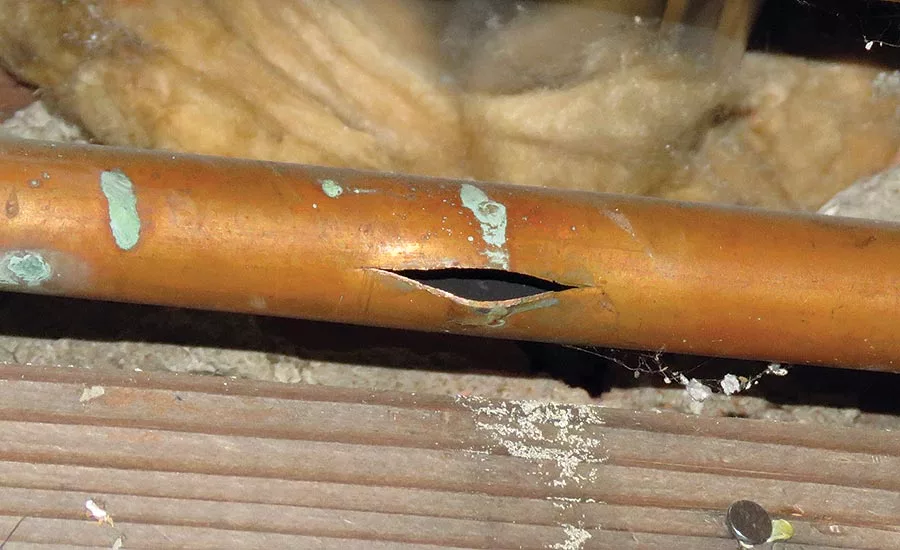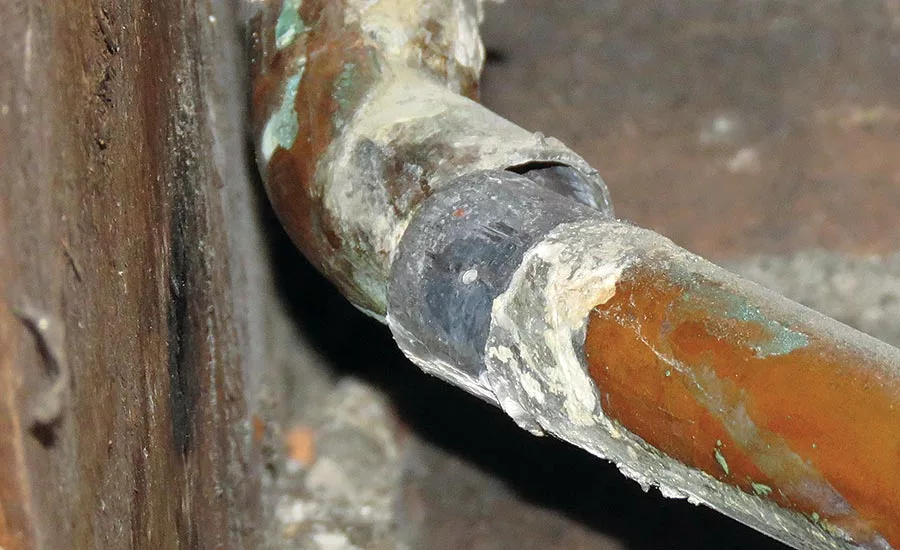Pipe freeze investigations
The how and why of frozen pipes.

A sufficiently low temperature for a pipe within a structure to freeze is typically when outside temperatures are 25° F or colder. The colder the temperature is, the less time it takes to freeze. Photo courtesy of Rimkus Consulting Group.

A typical ‘fish mouth’ rupture of a copper pipe. Photo courtesy of Rimkus Consulting Group.

Copper pipe separated at an elbow fitting. Photo courtesy of Rimkus Consulting Group.
Frozen pipes may seem like an age-old problem; however, they still occur frequently in colder climates and account for major losses in buildings. Understanding the science behind pipe freezes and investigating techniques will help determine why the pipe freeze occurred and what could have been done to prevent a reoccurrence.
Pipe freeze science
As you may have guessed, a water system pipe will freeze if exposed to a low enough temperature for a long enough time. A sufficiently low temperature for a pipe within a structure to freeze is typically when outside temperatures are 25° F or colder. The colder the temperature is, the less time it takes to freeze.
When the water in the pipe freezes, an ice plug forms inside the pipe, which expands about 9%. If the water on either side of the ice plug has somewhere to go, such as an open path back to the water supply, then the pressure will be relieved. However, if there is a restriction in the pipe, such as another ice plug or a closed valve (sink faucet, shower, etc.), then the pressure between the ice plug and the restriction greatly increases due to the expansion of the ice plug. Pressure in the pipe can exceed 10,000 psi, which can easily cause metal and rigid plastic pipe to burst, fittings to fracture or separate, or valves to break.
After the break occurs, pressure is relieved and the small amount of water between the ice plug and the restriction may leak out; however, most damage occurs after the ice plug melts and the water begins to flow. Thawing conditions typically occur when the outside temperature is at or above 35°. When the ice plug melts and the water supply is not isolated, the water will flow out of the break until such a time that the leak is identified and isolated. In some cases, such as when buildings are vacant, this duration may be months.
Identifying a cause
To understand the cause of a pipe freeze, the following questions are typically asked: Was there a construction defect? Was there a mechanical failure that caused a loss of heat? Was the heat on or off? What was the thermostat setting? Analyzing the characteristics of the pipe break, utility data and weather data will help in answering those questions.
The location of the pipe break can tell a lot about how the break may have occurred. For example, if the pipe break occurred on an exterior wall, then perhaps the pipe was outside of the thermal envelope of the building. That is generally caused by a construction defect where the pipe was not properly insulated, installed in the improper location or there may have been insufficient heat in the room. If the break location was on an interior wall, then there was likely insufficient heat in that room or the entire building.
Mechanical failure of a furnace or boiler can cause a loss of heat in the entire building, which typically results in multiple pipe breaks throughout the building. It is important to understand the condition of the furnace or boiler by checking for fault codes, tripped breakers, control settings, power supply and previous maintenance and repairs performed on the unit. If mechanical failure is suspected, then further investigation such as destructive inspection or testing may be required.
The thermostat settings should be documented to determine the status of the heating system. Was the heat set to off? What was the temperature setpoint? If the thermostat uses batteries, are they dead? Depending on the thermostat design, dead batteries may result in the unit going to full heat, or simply shutting off.
Analyzing utility usage
Utility records are often very helpful in supporting the investigation. A two-year history of utility usage (gas or oil, water and electricity) can be used to determine what the previous “normal” year of usage was vs. the current year when the freeze event occurred. Gas or oil usage data is useful in determining whether the furnace was operating. Water usage can be considered to determine how long the leak had occurred. And electricity usage may provide supporting information in conjunction with the other utilities to provide a basis for what may have occurred.
If a utility record, such as gas usage, indicated a negligible amount for a given month, then it is likely the furnace was not operating, and perhaps the only usage was due to pilot lights of other gas appliances in the building. However, a more calculated approach can be taken to determine if the weather conditions dictated use of heat or not. That approach uses heating degree days (HDD).
An HDD is 1° variation from 65° for one day. For example, an average temperature of 55° for one day would result in 10 HDD for that day. The cumulative total of HDD for a month can be calculated and compared to the gas usage (therms) for that month. Colder temperatures result in higher HDD, which typically indicates more gas usage for the furnace. Therefore, HDD and gas usage should track in a similar manner over time. If the gas usage tracks lower than the HDD, then less heat was used, which may have resulted from a lower thermostat setting or a furnace malfunction.
“Normal” usage for a building can be determined by calculating the therms per HDD, using gas usage records (actual usage; not estimated) and HDD data for the year prior to the freeze event. The therms per HDD provide a baseline utility usage for the heating system that can be compared to the period when the freeze event occurred. This method is useful in determining if gas usage was below normal, but the heat may have remained on. And to go one step further, thermal calculations can be performed, if the gas usage was determined to be below normal, using the actual gas usage and exterior temperatures to determine the approximate setting of the thermostat in the building.
Pipe freeze investigations can be complex; however, understanding the science behind pipe freezes and proper investigating techniques can simplify the process to determine a cause. Once the cause of a pipe freeze event is confirmed, corrective actions can be implemented to prevent a reoccurrence.
Looking for a reprint of this article?
From high-res PDFs to custom plaques, order your copy today!





